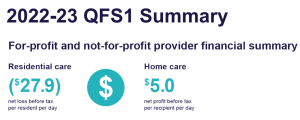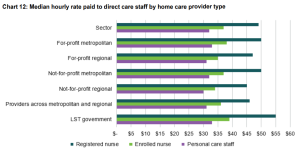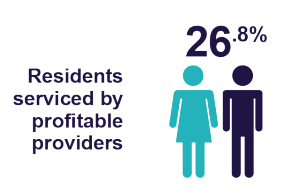The first Quarterly Financial Snapshot (QFR) of the Aged Care Sector, which contains data for the September 2022 quarter, reveals residential aged care providers lost $27.90 before tax for every resident, every day.
The losses includes non-current expenses, such as the write down of bed licences.

Grant Corderoy, Senior Partner with StewartBrown, said, “It is significant to understand why these large losses are being incurred.”
He pointed out that Direct Care operations are breaking even, but losses are being incurred for Indirect Care (everyday living) and Accommodation. Grant said reforms around consumers paying more for their daily services and accommodation, where they can afford to, are needed.
Aged and Community Care Providers Association (ACCPA) CEO, Tom Symondson, said the QFR reflects what the sector has been saying for some time "providers are struggling” – but the results are “even worse than we thought”.
The problems causing the problems are already well known: lack of funding, the pandemic, and workforce shortages, Tom said.
The losses “represent a loss of $465.3 million over the quarter or a potential full year loss of $1.86 billion,” he said.
"We are concerned about the longevity of the sector without funding intervention.”
Workforce
Average care minutes for aged care providers was 187 per resident per day. From October 2023, providers will be required to deliver 200 minutes per resident per day, and from October 2024, that number increased to 215. Amid severe staff shortages, it’s unclear how those mandatory requirements will be met.
Tom said the sector’s financial pressures will be “compounded” by the requirements for higher minutes of care and RNs 24/7.
ACCPA is also calling on the government to fully fund the Fair Work Commission work value case pay increase in full from the time the increase is granted – 30 June 2023.
AN-ACC
AN-ACC funding began from 1 October 2022, so is not reflected in the reporting period.
Grant said, “Our expectation is that there will be an improved financial performance as a result of the AN-ACC subsidy for Quarter 2 (December quarter) due to AN-ACC including funding to achieve the average 200 mandated minutes, but meeting this requirement not being compulsory until October 2023.
COVID-19 continues to have an impact on operating costs, especially during outbreaks which continue to occur. The report notes, “The correlating revenue through Australian Government grant support is unlikely to have been realised during the same quarter the increased expenses occurred” – a reference to the delay of several months for the Government to reimburse providers for the cost of their COVID expenses.
Funding
ACCPA is seeking an indexation increase for subsidies paid to aged care providers in line with the CPI, which currently stands at a 30-year high of 7.8%.
Tom echoed Grant’s call for increased contributions from consumers who can afford to pay more for their aged care.
“The parlous state of aged care providers means that we need to examine different funding options including the possibility that those who have the means are asked to contribute more for their care,” he said.
Other highlights from the report include:
- Only 25% of Not For Profit providers were profitable, and only 47% of For Profit providers.
- Two providers left the residential aged care sector, but two entered the sector.
- 75% of providers did not report any expenditure on allied Nearly one third – 30% – did not report any expenditure on speech pathologists, podiatrists or dietetic care. However, the report notes that this is the first time providers have been required to report on allied health and these services are often provided through contractors. Over time, the Department expects this data will improve.

- The total cost of food and ingredients was $12.40 per resident per day, of which 81% was on fresh food and ingredients.
- The median proportion of wages to revenue was 74%.

- The sector median of the average hourly rate was $45 for registered nurses, $33 for enrolled nurses and $27 for personal care workers.

- Only 27% of aged care residents reside with profitable providers – as opposed to 77% for home care recipients.
- The mandatory quarterly financial reporting is unaudited but signed off by the provider’s board.
Increased financial reporting was a recommendation of the Aged Care Royal Commission, to enable benchmarking between providers, improve monitoring, and to feed into publications such as the Star Ratings and the Food and Nutrition Report. Grant said the report was “timely and relevant” and shows the benefits of transparency.










